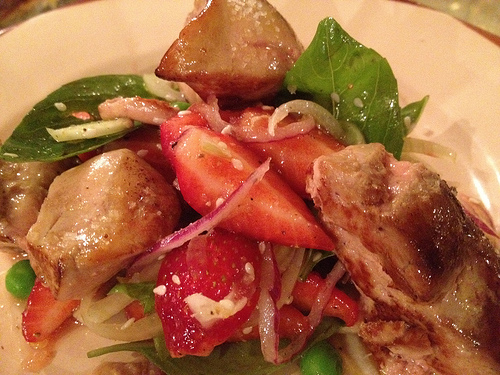 |
| Bas-relief in the tomb of Mereruka, Saqqara, |
Foie gras (literally 'fat liver') is a French delicacy made from the artificially enlarged livers of force-fed ducks or geese. The origins of the dish appear to date back to at least 2500 B.C.E. with the force-feeding of geese appearing in a bas-reliefs
throughout Ancient Egyptian tombs in Giza and Saqqarah. It's not clear if the Egyptians specifically sought the livers of their fattened animals but
the Romans certainly did. After the fall of the Roman empire foie gras largely vanished from European plates until the 16th century when in 1570 Bartolomeo Scappi (chef de cuisine for Pope Pius V) included it in his
Opera dell'arte del cucinare.
 |
| Modern computer controlled force-feeding |
It's believed that foie gras survived the thousand years between the fall Roman empire and its reappearance on gentile plates because of its
importance in the Jewish culinary oeuvre, as a replacement for religiously proscribed lard and dairy fat. One of Europe's largest Jewish populations, at the time, lived in northeastern France. As the French ruling classes sought ever more ostentatious displays of wealth, the expense, delicacy and exoticism saw foie gras become an increasingly regular presence on the tables of the aristocracy throughout the 17th century.
While by the 1800s foie gras had cemented its place in French haute cuisine, it wasn't until the 1970s that its consumption became widespread in France. Today, France produces around 80% of the world's foie gras and eats around 90%. The industry is worth and estimated $US 2.5 billion to the country.
 |
| Seared foie gras, served with stawberries. |
Foie gras is considered a particular delicacy due to the rich buttery taste imparted by its extremely high fat content. While most familiar to Australian diners as pâté, or other similiar low temperature preparations, increasingly it is served in France
roasted, grilled or sauteed. The difficulty of cooking the delicate organ without burning it adds to the luxury value of the dish, as only highly skilled chefs can achieve satisfactory results. Once cooked, the liver is so flavorsome that it requires little or no seasoning.
Serious concerns around the ethics of foie gras production (ramming a life-time's worth of grain down a bird's throat in the space of 2 weeks is a
pretty nasty exercise) mean that
many jurisdictions now ban the production or import of foie gras from force fed animals. Luckily, for ethical gourmands there's hope yet.
Increasingly, foie gras is produced by timing the slaughter to coincide with natural, seasonal, engorgement of duck and geese livers. Hope for bird-lovers everywhere!



No comments:
Post a Comment